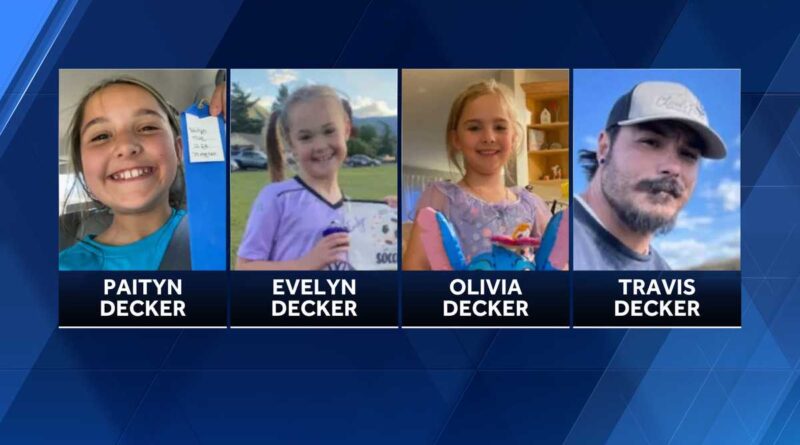The Decker Sisters Bodies Found in Chelan County Washington
The murder of Paityn (9), Evelyn (8), and Olivia (5) Decker in Chelan County, Washington, on June 2, 2025, shocked a region already rallying around family, community, and grief. The three sisters—ages 9, 8, and 5—were vibrant children known for their warmth, humor, and the small rituals that bound their family together. Their deaths, ruled homicides by suffocation, unfolded amid an intense manhunt for their father, Travis Decker, who was last seen after failing to return them following a scheduled visitation. The case exposed fractures in systems, galvanized a community into collective mourning and remembrance, and left lingering questions about prevention, mental health, and legacy.
The Children and the Family Ritual That Defined Them
Paityn, Evelyn, and Olivia Decker were more than victims; they were the center of a family’s emotional world. Those who knew them described distinct personalities that complemented one another. Paityn was outgoing, often showering others with compliments and making people laugh. Evelyn was quieter, forging deep one-on-one connections and reflective in her care for others. Olivia, the youngest, carried what was described as an ever-present happiness—a lightness that lifted the mood around her.
Their mother, Whitney Decker, had instilled a family tradition called “the three feelings.” Each night, every family member shared three emotions they had experienced that day. It was a ritual designed to keep emotional honesty and connection alive, a small practice that became a defining thread in their relationships. Whitney later referenced this tradition in a memorial speech, urging others to adopt their own version as a way of keeping her daughters’ legacy alive: a practice of emotional awareness, intentional kindness, and daily checking-in that the girls had embodied.
The bond the sisters had with one another was palpable to the community. They were remembered in public remembrances not just by name, but by the ways they made their corner of the world softer—through laughter, dance, quiet affection, and consistent positivity. In the wake of their deaths, these recollections were repeated like prayers: the girl who made everyone feel seen, the child who kept secrets close, the little one who radiated joy with no pretense. The loss was described as a void that could not be filled.
The Scheduled Visitation and the Disappearance
On May 30, 2025, the three girls were with their father, Travis Decker, for a scheduled visitation. That visitation would become the last time they were seen alive. When Whitney did not receive them back as planned, concern mounted quickly. An endangered missing person advisory was issued, and efforts to locate the girls began in earnest. What followed was a tense, harrowing period of uncertainty that spread through the Wenatchee Valley and beyond.
As days passed with no confirmed sighting of the girls, law enforcement intensified their search. The public was urged to remain vigilant, and the emotional toll on the family and community compounded with every hour of uncertainty. The advisory was a signal not just of procedural escalation, but of raw collective worry. Under that pressure, hope frayed but did not break—until June 2, when the unimaginable was confirmed.
Discovery and Crime Scene
On June 2, 2025, the bodies of Paityn, Evelyn, and Olivia were discovered near Rock Island Campground in Chelan County, Washington. The scene shattered whatever remaining hope lingered. The autopsies would later determine that all three girls had been suffocated; the deaths were ruled homicides. Each girl was found with a plastic bag over her head and their wrists bound with zip ties. The brutality of the method, coupled with the young ages of the victims, intensified the public horror.
Travis Decker’s pickup truck was recovered at or near the scene, and investigators recovered a substantial amount of physical evidence from it. Blood was present in various locations—some tested as human male blood, and at least one sample was noted as non-human. Apparent handprints in blood were visible on the truck’s tailgate. Authorities collected items, including personal effects tied to Decker, and began rigorous forensic analysis. DNA and fingerprint testing were launched to create a clearer picture of the timeline, movements, and involvement of individuals at the scene.
Law enforcement quickly focused on Travis Decker as the central suspect. The evidence pointing to his involvement, bolstered by the nature of the disappearances, the recovered vehicle, and forensic markers, led to him being charged with three counts of first-degree murder and three counts of first-degree kidnapping. The investigation, while rapidly identifying the presumed assailant, entered a different phase: the pursuit.
The Manhunt for Travis Decker
Once the girls’ bodies were found, the focus pivoted to locating their father. Decker was considered dangerous—an Army veteran with extensive training, including deployment to Afghanistan in 2014. His military background, combined with reported struggles with mental health including PTSD and a history of transient living (he was described as homeless, often living in his vehicle or temporary locations), formed a profile of someone with survival skills and unpredictability. Authorities cautioned the public against approaching him, stressing that he should be considered armed and dangerous.
The manhunt expanded across rugged and remote terrain in Chelan County and surrounding areas. Federal authorities, including U.S. Marshals, were brought in to assist, and local teams rotated to ensure sustainability of search efforts. The search area spanned hundreds of square miles, including forested tracts, abandoned structures, and locations where he was possibly last seen. There was a dual narrative in the public reporting: officials were pursuing Decker aggressively, but they also publicly acknowledged the possibility that he might be deceased, which introduced a complex calculus in how resources were allocated—balancing the need to find him if alive versus recovering a body if he had succumbed to the elements.
During the manhunt, authorities released physical descriptions and urged the public to submit tips. Decker was described as approximately 5’8” with black hair and brown eyes; the last known clothing reports included a light-colored shirt and dark shorts. Rewards were offered for information leading to his capture, and the community was implored to remain alert, especially in rural and wooded areas where he might attempt to blend or find refuge.
Community Grief, Response, and Tribute
The local community’s response to the deaths of the Decker sisters was immediate, sustained, and deeply personal. In the days following June 2, memorials popped up across Wenatchee and the surrounding valley. Trees were adorned with ribbons in the girls’ favorite colors—pink, purple, and green. Notes, photos, stuffed animals, flowers, and other tokens of remembrance accumulated in public spaces and at makeshift shrines. Law enforcement officers wore colored mourning badges in tribute, and the symbols of collective grief became part of the landscape.
Public memorial events drew hundreds and then thousands. On June 5, a solemn gathering at Memorial Park allowed community members to come together, speak names, and share memories. Later, a larger memorial at Rocky Reach Dam Park drew more than 1,500 people—neighbors, strangers, first responders, and family—all converging to stand in solidarity with Whitney Decker and to ensure the girls were not forgotten. During these events, people shared small stories: the way Paityn would make someone’s day, Evelyn’s artistic flare and connectiveness, and Olivia’s laugh that could fill a room. These weren’t mere anecdotes; they were the antidote to dehumanization in tragedy, affirming the girls’ full humanity.
At the memorial on June 20, Whitney Decker made one of her first public appearances since the tragedy. Her speech was raw, grounded, and centered less on the violence of their deaths and more on the values the girls lived by. She reiterated the importance of “the three feelings,” inviting the community to adopt their own emotional check-ins to foster connection, empathy, and daily intentionality. Her reflections on each daughter—Paityn’s generosity, Evelyn’s quiet intimacy, Olivia’s joy—served as a lasting portrait, a pushback against the void the crime created.
The community also began organizing long-term remembrances: discussions of scholarships in the girls’ names, preservation of memorial displays, and ensuring the story of their lives was integrated into local efforts around healing. Fundraising efforts for Whitney, intended to help with costs related to the tragedy and legal proceedings, saw an outpouring of public support, markedly surpassing initial expectations and demonstrating collective commitment beyond immediate grief.
Background Context: Visitation, Mental Health, and Systemic Questions
The relationship between the parents, court-mandated conditions, and oversight of visitation came into sharper focus after the news broke. Decker had prior history that included concerns over mental health—his ex-wife’s attorney noted struggles with PTSD and other issues. There had been past restrictions around visitation, and recommendations for things like anger management and counseling were issued in 2024 under a temporary parenting plan. Whether those safeguards were sufficient, appropriately enforced, or timely became a subject of quiet reflection among some community voices after the fact.
Critics and observers also raised conversations about alert systems and timing. The case prompted renewed discussion about the criteria and speed of issuing public alerts in missing children cases. Some wondered whether earlier systemic intervention, more robust support structures around mental health follow-up, or different risk assessments around supervised visitations could have shifted the trajectory. These conversations were not framed as accusations but as part of a broader call to learn—seeking to prevent future tragedies by understanding the intersection of family law, mental health monitoring, and child safety protocols.
The Ongoing Search and Uncertainty
As weeks passed, the manhunt for Travis Decker persisted, with periodic updates from law enforcement alternating between cautious optimism about finding him alive and sobering acknowledgment of the challenges. Search strategies adapted to environmental conditions, tip verifications, and the potential that Decker might be moving or hiding in unpredictable patterns. Authorities maintained the posture that the situation was fluid: he could still be alive and dangerous, or may have already died in remote terrain, making recovery equally important in either scenario for closure and justice.
The unresolved status of the suspect added an extended layer of communal stress. In the absence of a resolution—apprehension, confirmation of death, or trial—the narrative remained suspended between grief for the past and fear of an unknown future. This liminality sustained public interest, media attention, and continued vigilance among those who still hoped for definitive answers.
Legacy and Long-Term Impact
The murder of the Decker sisters created reverberations beyond immediate grief. The sisters’ names became shorthand for the fragility of childhood, the imperative of community solidarity, and the complexities of balancing parental rights with protective oversight in families with mental health and domestic turbulence. Whitney Decker’s choice to lean into her daughters’ emotional legacy—inviting people to practice emotional honesty and mutual care—transformed pain into an actionable ethos that many adopted in their own circles.
Memorialization took tangible form in scholarships, memorial displays, and continued public remembrance at anniversaries. The community’s efforts to preserve the memory of the girls underscored an intention that their lives would not be defined solely by their deaths, but by the love they gave and the practices they inspired.
The investigative and systemic scrutiny that followed also introduced potential incremental changes in how similar cases might be handled, especially around alert timing, communication between family court and child welfare systems, and how mental health disclosures are managed within custodial arrangements. Whether those conversations will yield policy adjustments remains to be fully seen, but the case has already embedded itself in local institutional memory.
Conclusion
The murder of Paityn, Evelyn, and Olivia Decker on June 2, 2025, in Chelan County, Washington, is a tragedy layered with brutality, loss, and a community’s raw response. The imagery of three young sisters silenced in a violent, intentional way is seared into the collective consciousness, yet what endures alongside the horror is the picture of their lives: the ritual of three feelings, the laughter, the kindness, the way a community rallied to hold the space for mourning and remembrance. The manhunt for their father, Travis Decker, prolonged the uncertainty, keeping the story in national and regional awareness. In the aftermath, the sisters’ memory has become a call to deeper emotional connection, better systemic vigilance, and a reminder that even in the darkest moments, communities can forge light through shared grief and collective legacy-building.
Discover more from City Towner
Subscribe to get the latest posts sent to your email.




